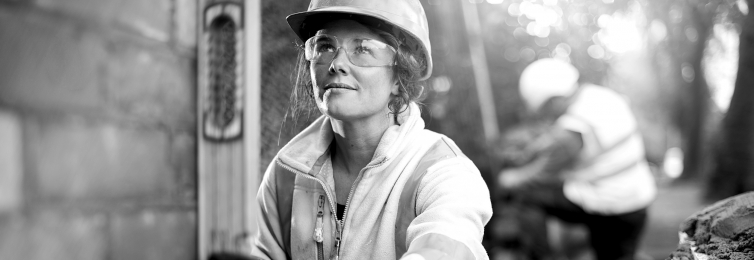Inspect before you step
Ladders are an indispensable tool on the job-site, necessary for virtually every activity in construction. The average worker will spend a significant amount of their workday using ladders, either going to the next level or doing work from a ladder. But before taking the first step onto the initial rung, a thorough inspection is required to establish your ladder is safe to use. Here, industry expert David Beauchamp, Senior Risk Management Consultant for Builders Mutual, shares the best practices for ladder inspection.
Is it the right tool?
One of the most common issues in ladder safety or, rather, unsafe ladder use, involves people using ladders in ways other than what they were designed for. One example is using a stepladder as an extension ladder to try to reach farther. A ladder is a tool, just like any other piece of equipment on the job-site, and it shouldn’t be misused. Whether a worker is just trying to save time or has a tendency to improvise, going out of bounds with ladders can be very dangerous.
Supervisors and safety managers must educate their teams about different types of ladders and how they are designed to be used properly. Stepladders, for instance, are designed to be worked from, such as by painters who are on ladders for hours at a time. Roofers, on the other hand, use extension ladders to get from point A to point B. Be sure to use the right ladder for the job.
In addition to proper use, proper selection is based on the material the ladder is made of. Generally, ladders are either wooden, aluminum, or fiberglass. Wood ladders are a disappearing breed, but when used, they should be for very light duty. On the construction site, wood will eventually rot from weather exposure, making it very unsafe. Aluminum is used more often, but it is not the preferred job-site ladder material due to its conductive nature. Standing on metal around electricity is never a good idea. Doing finish painting, however, is a case when an aluminum ladder would be acceptable. Fiberglass ladders are ideal because they are nonconductive, so the danger of exposure to wires, power tools, etc. is minimized.
Finally, workers always need to identify the ladder’s duty rating, or weight capacity, which ranges from 200 to 375 pounds across five ratings. If the rating is Type II Medium Duty (225 pounds), for example, remember that it’s not just the person’s weight that must be considered, but also gear, tools, and material that will be placed on the ladder. The rating placard (and all warning placards) should be legible. If it is not, that ladder needs to be tagged out until a replacement placard is attached.
Bottom-up inspection
An effective way to quickly assess whether your ladder is safe and ready to use is to start with a general overview and then go from the base up.
- Check for dirt, grease, and dampness. If needed, clean the ladder of general grime and solvents. Take time to rinse off sawdust, which is prevalent on every job-site. Make the same inspection of the user’s shoes, ensuring there’s no grease, sawdust, or wetness before you step up.
- Look at the “shoes” of an extension ladder. Inspect them to be sure the rubber/nonslip tread is intact and that the shoes are firmly attached to the ladder. The ladder is only as good as the shoes. And remember: Shoes are down for solid surfaces and concrete, and they are up when working on dirt or loose soil, so the ladder legs dig into the dirt.
- Check the rubber tread on the foot of a stepladder. Be sure the tread is even and intact and not warped or missing.
- Ensure it’s steady and strong. Run your hands along the siderails to check whether the ladder is uneven, warped, bent, or splintering. Is there excessive corrosion? When you lay the ladder on its side, is it straight?
- Confirm rung-readiness. Ensure that each rung is still firmly attached to siderails. Check that all rivets/brackets/bolts are intact and that no rung is warped or bent. Work your way up, rung by rung.
- Inspect the spreaders on a stepladder. Make sure they fully extend into locking position, and check that they are not bent or warped.
- With extension ladders, make sure the locking mechanism works. Extend the locking bars completely to check that they’re functioning normally. Use the rope and pulley to be sure all the components are operating properly and that the rung locks are functioning.
If, after inspection, you find that a ladder is damaged, it may be tempting to try and repair it. But do not do this on the job-site. Many falls and injuries stem from workers attempting to fix ladders with duct tape or other inappropriate means of repair. Tag it “Do Not Use” and find another ladder that’s in good working condition. After you tag out a ladder, move it completely off the job-site, because ladders often make their way back into use when tagged and still onsite. Sometimes, they are even resurrected from the dumpster.
A last word on ladder use
Another aspect of ladder inspection is to recognize the limitations of ladders in general. Ladders aren’t necessarily always the ideal for working from heights. There are alternatives, especially for extended work-from-ladder scenarios. Consider a scissor lift, accordion lift, aerial lift, or scaffolding, so you can focus on your work while using both hands for extended periods of time. Today, there are also podium-style ladders, which provide a place to stand and have surrounding rails offering additional protection. These are great, and safe, options for jobs like interior painting.
Year after year, fall injuries continue to be the leading injury in construction. In the “falling from elevation” category, ladder falls are the most frequent. Roofing falls may have more fatalities, but ladder falls are significantly more common. Want more information? Here is a ladder safety flyer from Builders Mutual. Plus, you can check out these resources from Stopconstructionfalls.com to learn more and help spread the word about ladder safety on your job-site.
Content Updated 1-2024




 Find an
Find an